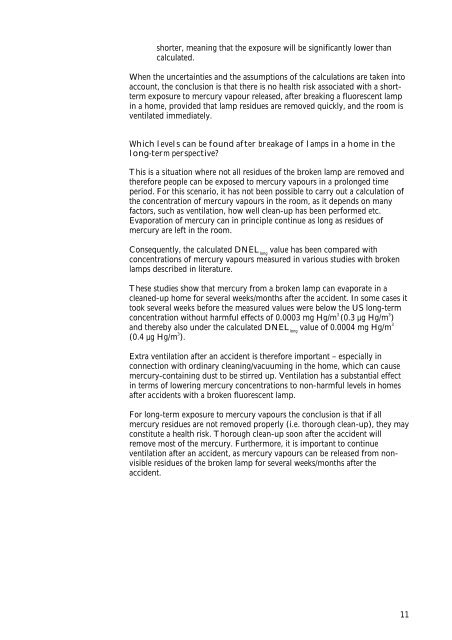No. 104 - Miljøstyrelsen
No. 104 - Miljøstyrelsen
No. 104 - Miljøstyrelsen
You also want an ePaper? Increase the reach of your titles
YUMPU automatically turns print PDFs into web optimized ePapers that Google loves.
shorter, meaning that the exposure will be significantly lower than<br />
calculated.<br />
When the uncertainties and the assumptions of the calculations are taken into<br />
account, the conclusion is that there is no health risk associated with a shortterm<br />
exposure to mercury vapour released, after breaking a fluorescent lamp<br />
in a home, provided that lamp residues are removed quickly, and the room is<br />
ventilated immediately.<br />
Which levels can be found after breakage of lamps in a home in the<br />
long-term perspective?<br />
This is a situation where not all residues of the broken lamp are removed and<br />
therefore people can be exposed to mercury vapours in a prolonged time<br />
period. For this scenario, it has not been possible to carry out a calculation of<br />
the concentration of mercury vapours in the room, as it depends on many<br />
factors, such as ventilation, how well clean-up has been performed etc.<br />
Evaporation of mercury can in principle continue as long as residues of<br />
mercury are left in the room.<br />
Consequently, the calculated DNEL long value has been compared with<br />
concentrations of mercury vapours measured in various studies with broken<br />
lamps described in literature.<br />
These studies show that mercury from a broken lamp can evaporate in a<br />
cleaned-up home for several weeks/months after the accident. In some cases it<br />
took several weeks before the measured values were below the US long-term<br />
concentration without harmful effects of 0.0003 mg Hg/m 3 (0.3 µg Hg/m 3 )<br />
and thereby also under the calculated DNEL long value of 0.0004 mg Hg/m 3<br />
(0.4 µg Hg/m 3 ).<br />
Extra ventilation after an accident is therefore important – especially in<br />
connection with ordinary cleaning/vacuuming in the home, which can cause<br />
mercury-containing dust to be stirred up. Ventilation has a substantial effect<br />
in terms of lowering mercury concentrations to non-harmful levels in homes<br />
after accidents with a broken fluorescent lamp.<br />
For long-term exposure to mercury vapours the conclusion is that if all<br />
mercury residues are not removed properly (i.e. thorough clean-up), they may<br />
constitute a health risk. Thorough clean-up soon after the accident will<br />
remove most of the mercury. Furthermore, it is important to continue<br />
ventilation after an accident, as mercury vapours can be released from nonvisible<br />
residues of the broken lamp for several weeks/months after the<br />
accident.<br />
11

















